1997 CHEVROLET EXPRESS ignition
[x] Cancel search: ignitionPage 38 of 386

Downloaded from www.Manualslib.com manuals search engine 0 Let only qualified technicians work on your air bag
system. Improper service can mean that your air
bag system won’t work properly. See your dealer
for service.
NOTICE:
If you damage the covering for the driver’s or the
right front passenger’s air bag, the bag may not
work properly. You may have to replace the air
bag module in the steering wheel or both the
air
bag module and the instrument panel for the
right front passenger’s air bag.
Do not open or
break the air bag coverings.
Servicing Your Air Bag-Equipped Vehicle
Air bags affect how your vehicle should be serviced.
There are parts of the air bag system in several places
around your vehicle. You don’t want the system to
inflate while someone is working on your vehicle.
Your
GM dealer and the GM Service Manual have
information about servicing your vehicle and the air bag
system.
To purchase a service manual, see “Service and
Owner Publications’’
in the Index.
For up to 10 minutes after the ignition key is
turned off and the battery is disconnected, an air
bag can still inflate during improper service. You
can be injured
if you are close to an air bag when
it inflates. Avoid wires wrapped with yellow tape
or yellow connectors. They are probably part of
the
air bag system. Be sure to follow proper
service procedures, and make sure the person
performing work for you
is qualified to do so.
The air bag system does not need regular maintenance.
Page 62 of 386
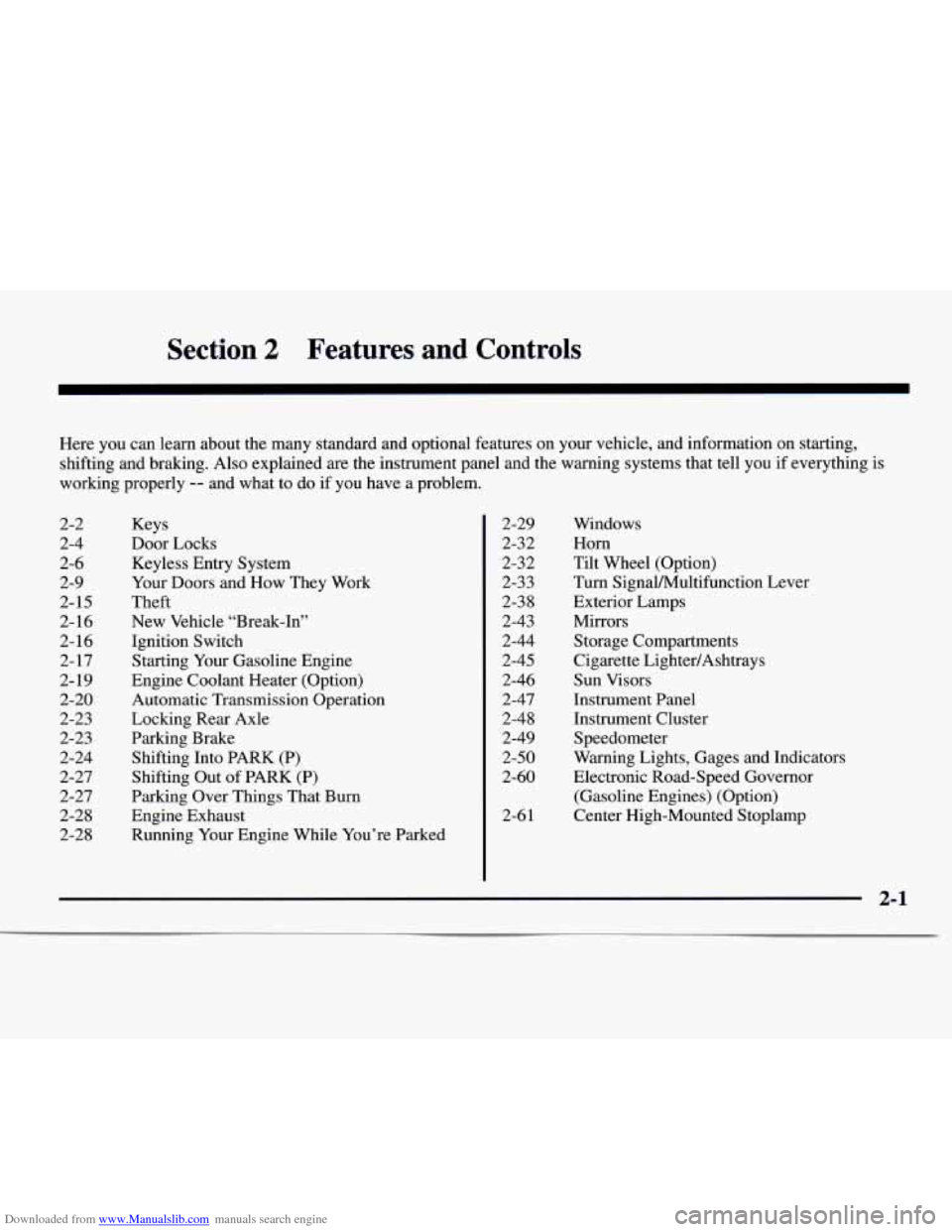
Downloaded from www.Manualslib.com manuals search engine Section 2 Features and Controls
Here you can learn about the many standard and optional features on your vehicle, and information on starting,
shifting and braking. Also explained are the instrument panel and the warning systems that tell you if everything is
working properly
-- and what to do if you have a problem.
2-2
2-4
2-6
2-9
2-15
2-16
2-16
2-17
2-19
2-20
2-23
2-23
2-24
2-27
2-27
2-28
2-28 Keys
Door Locks Keyless Entry System
Your Doors and How They Work
Theft
New Vehicle “Break-In”
Ignition Switch
Starting Your Gasoline Engine
Engine Coolant Heater (Option)
Automatic Transmission Operation
Locking Rear Axle
Parking Brake
Shifting Into PARK
(P)
Shifting Out of PARK (P)
Parking Over Things That Burn
Engine Exhaust
Running Your Engine While You’re Parked
2-29
2-32
2-32
2-33
2-38
2-43
2-44
2-45
2-46
2-47
2-48
2-49
2-50
2-60
2-6
1
Windows
Horn
Tilt Wheel (Option) Turn Signal/Multifunction Lever
Exterior Lamps
Mirrors
Storage Compartments
Cigarette LightedAshtrays
Sun Visors
Instrument Panel
Instrument Cluster
Speedometer
Warning Lights, Gages and Indicators
Electronic Road-Speed Governor
(Gasoline Engines) (Option)
Center High-Mounted Stoplamp
Page 63 of 386
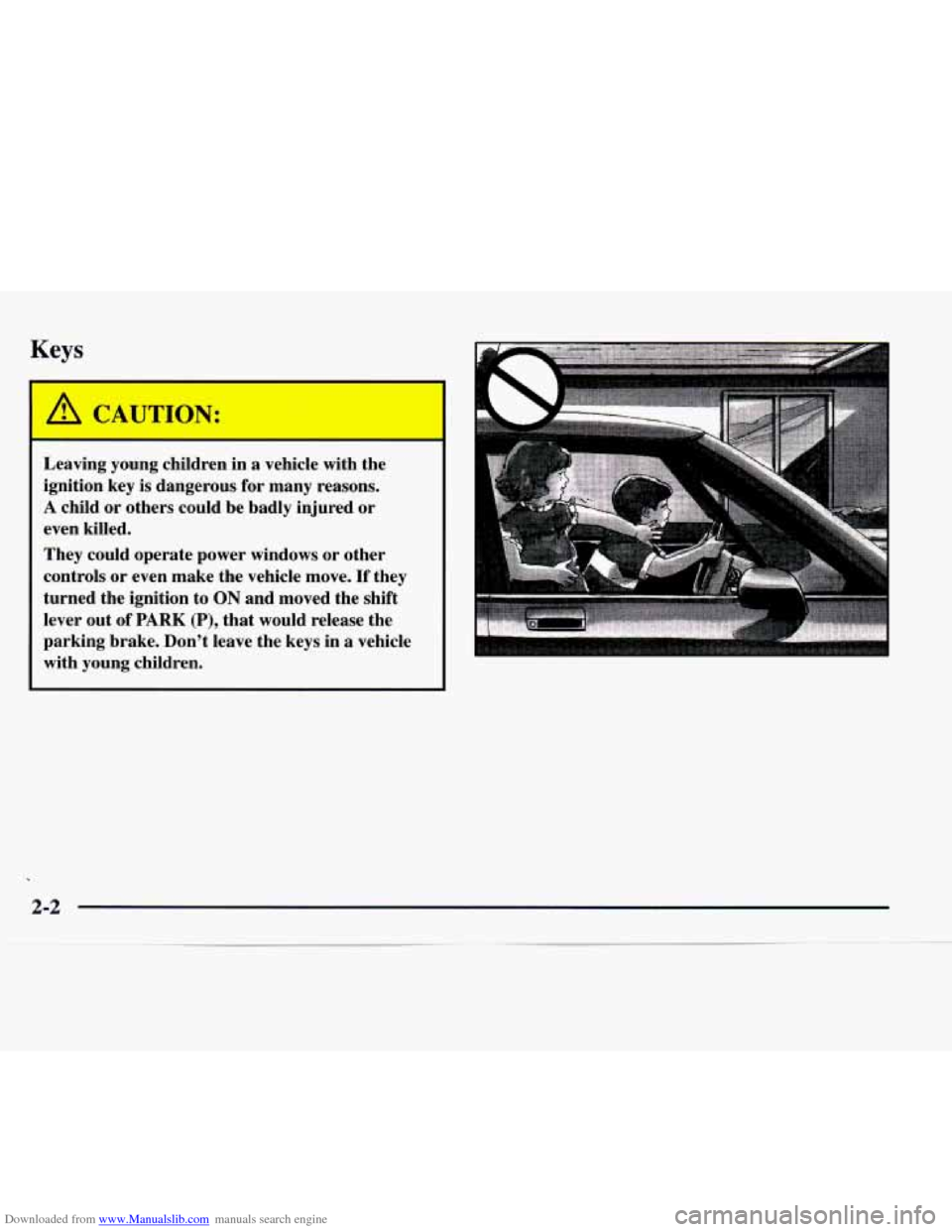
Downloaded from www.Manualslib.com manuals search engine Keys
A CAUTION:
Leaving young children in a vehicle with the
ignition key is dangerous for many reasons.
A child or others could be badly injured or
even killed.
They could operate power windows or other
controls or even make the vehicle move.
If they
turned the ignition to
ON and moved the shift
lever out of
PARK (P), that would release the
parking brake. Don’t leave the keys in a vehicle
with young children.
Page 64 of 386
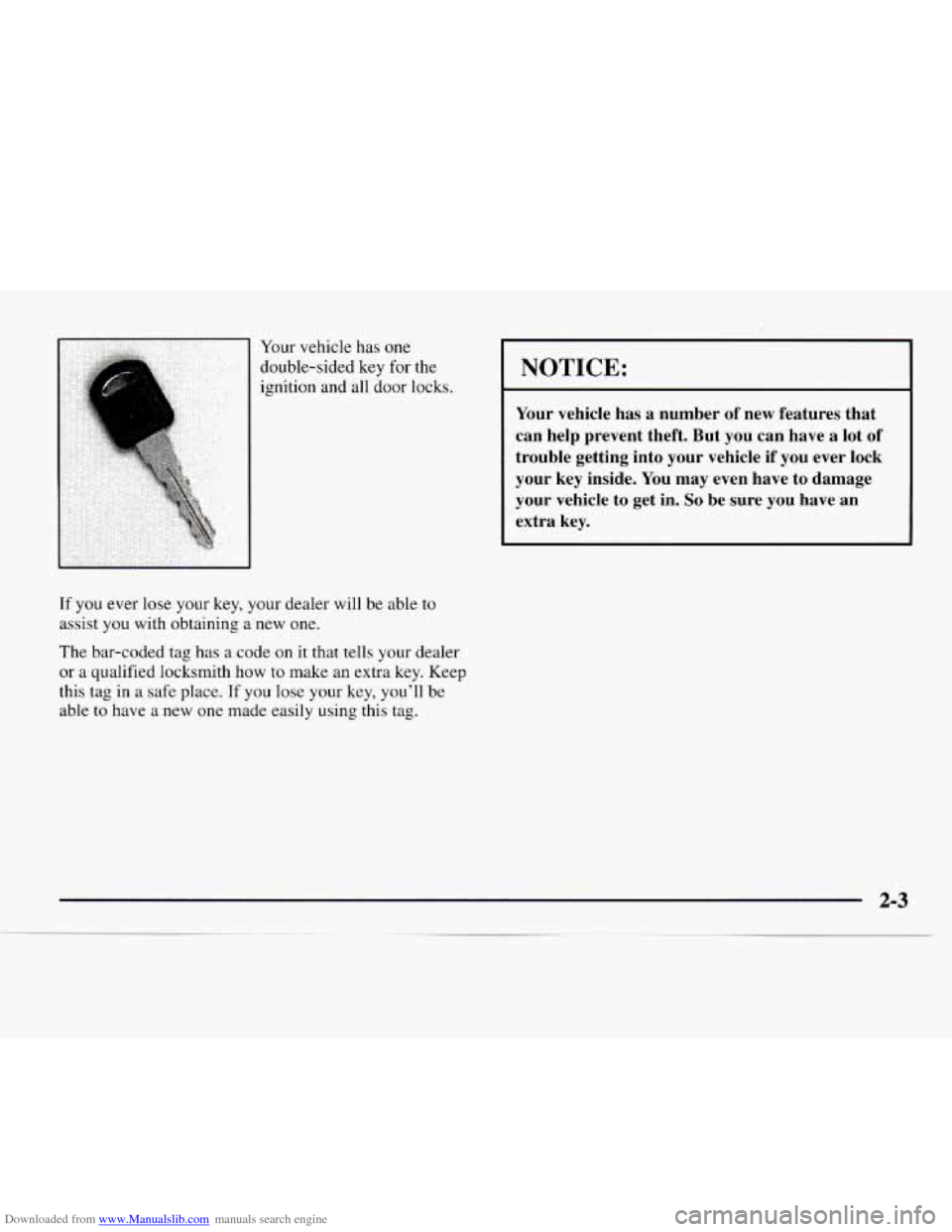
Downloaded from www.Manualslib.com manuals search engine Your vehicle has one
double-sided key
for the
ignition and all door locks.
If you ever lose your key, your dealer will be able to
assist you with obtaining a new one.
The bar-coded tag has a code
on it that tells your dealer
or a qualified locksmith
how to make an extra key. Keep
this tag in a safe place.
If you lose your key, you’ll be
able to have
a new one made easily using this tag.
NOTICE: - - ~ -
Your vehicle has a number of new features that
can help prevent theft.
But you can have a lot of
trouble getting into your vehicle if you ever lock
your key inside. You may even have to damage
your vehicle to get in.
So be sure you have an
extra key.
Page 68 of 386
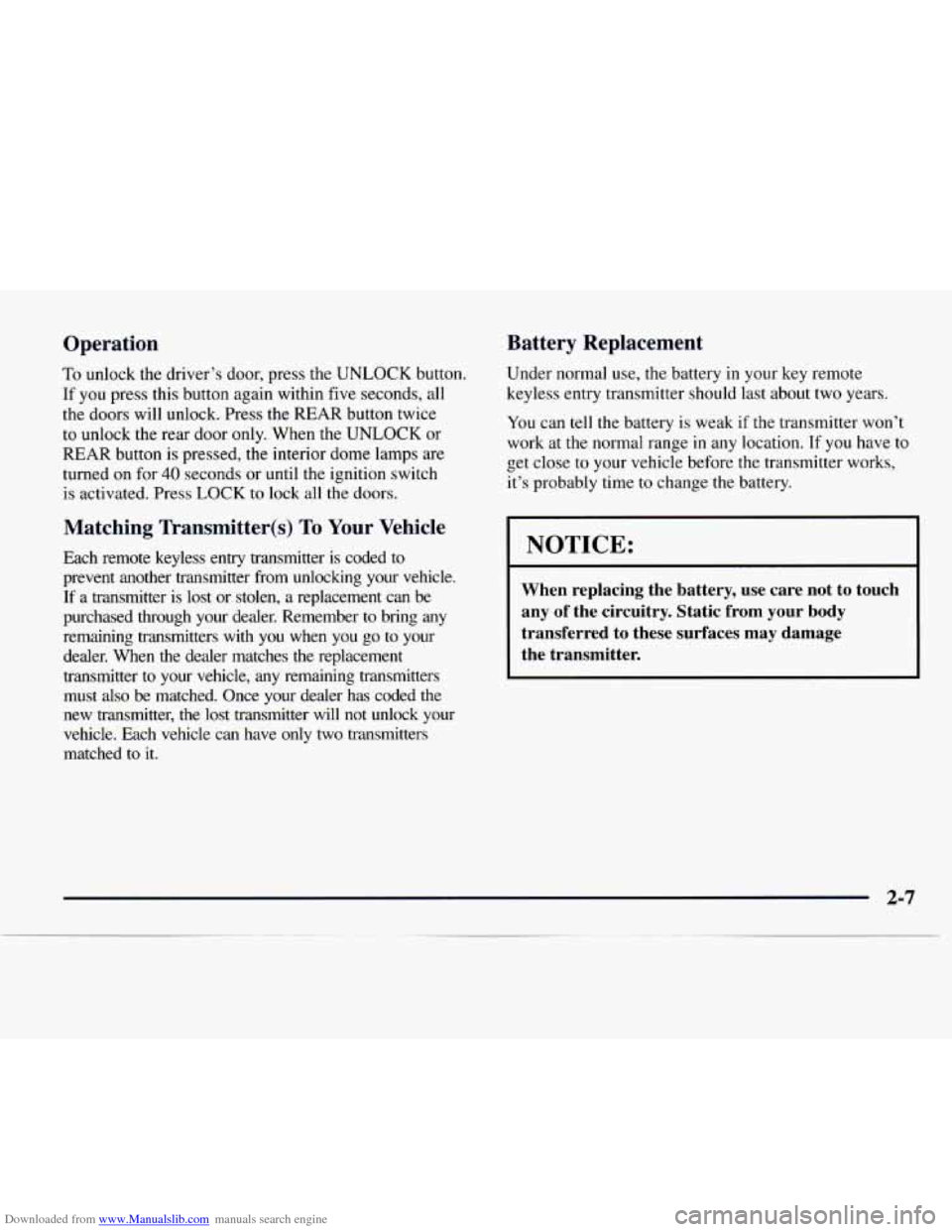
Downloaded from www.Manualslib.com manuals search engine Operation
To unlock the driver’s door, press the UNLOCK button.
If you press
this button again within five seconds, all
the doors will unlock. Press the
REAR button twice
to unlock the rear door
only. When the UNLOCK or
REAR button is pressed, the interior dome lamps are
turned on for
40 seconds or until the ignition switch
is activated. Press
LOCK to lock all the doors.
Battery Replacement
Under normal use, the battery in your key remote
keyless entry transmitter should last about two years.
Matching Transmitter(s) To Your Vehicle
Each remote keyless entry transmitter is coded to
prevent another transmitter from unlocking your vehicle.
If a transmitter is lost or stolen, a replacement can be
purchased through your dealer. Remember to bring any
remaining transmitters with
you when you go to your
dealer. When the dealer matches the replacement
transmitter to your vehicle,
any remaining transmitters
must also be matched. Once your dealer has coded the
new transmitter, the lost transmitter will not unlock your
vehicle. Each vehicle can have only two transmitters
matched to
it.
You can tell the battery is weak if the transmitter won’t
work at the normal range
in any location. If you have to
get close to your vehicle before the transmitter works,
it’s probably time to change the battery.
I NOTICE:
~~~~~ ~~
When replacing the battery, use care not to touch
any
of the circuitry. Static from your body
transferred to these surfaces may damage
the transmitter.
Page 76 of 386
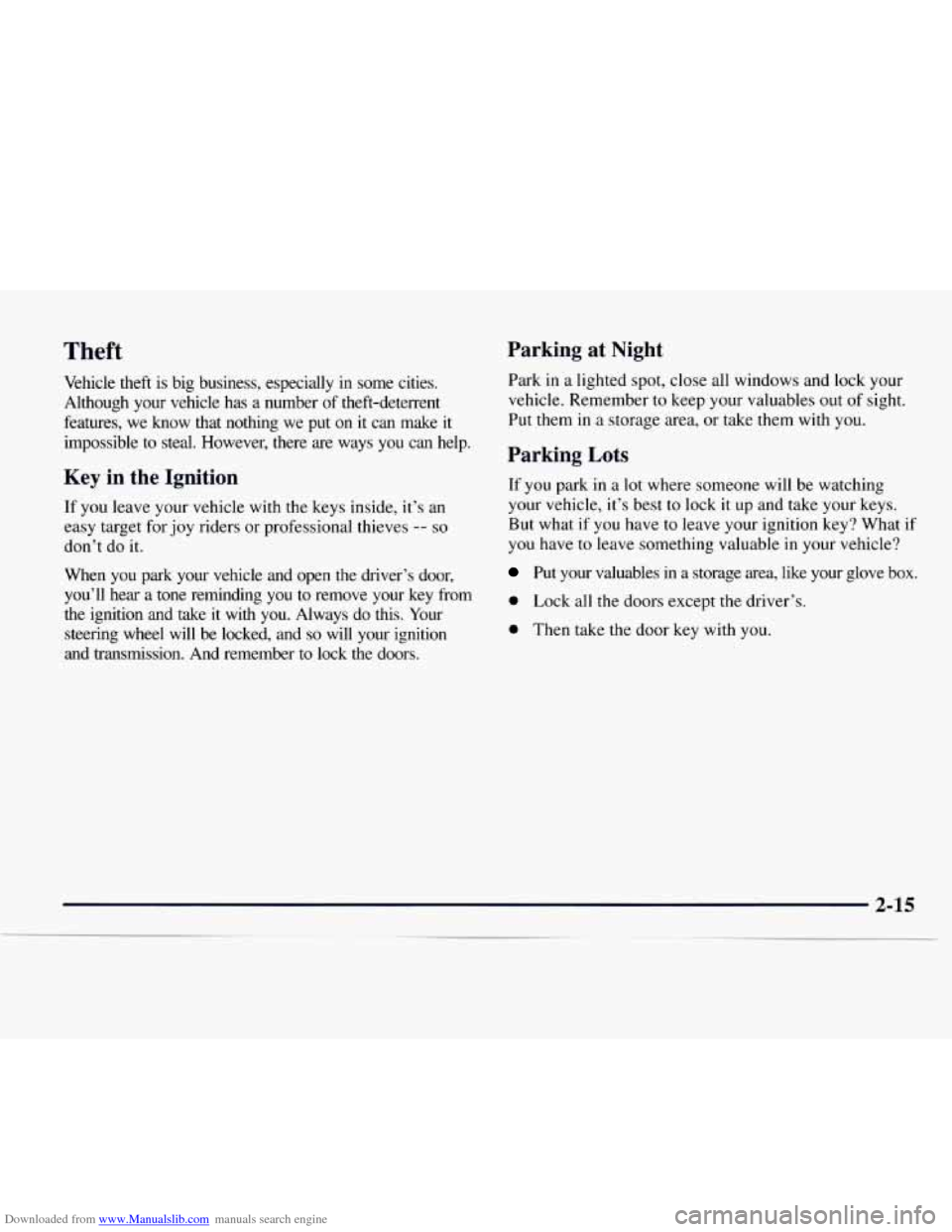
Downloaded from www.Manualslib.com manuals search engine Theft
Vehicle theft is big business, especially in some cities.
Although your vehicle has a number
of theft-deterrent
features, we know that nothing we put
on it can make it
impossible
to steal. However, there are ways you can help.
Key in the Ignition
If you leave your vehicle with the keys inside, it’s an
easy target for joy riders
or professional thieves -- so
don’t do it.
When you park your vehicle and open the driver’s door, you’ll hear a tone reminding you to remove your key from
the ignition and take
it with you. Always do this. Your
steering wheel will be locked, and
so will your ignition
and transmission. And remember to lock the doors.
Parking at Night
Park in a lighted spot, close all windows and lock your
vehicle. Remember to keep your valuables out
of sight.
Put them in
a storage area, or take them with you.
Parking Lots
If you park in a lot where someone will be watching
your vehicle, it’s best
to lock it up and take your keys.
But what if you have
to leave your ignition key? What if
you have to leave something valuable in your vehicle?
Put your valuables in a storage area, like your glove box.
0 Lock all the doors except the driver’s.
0 Then take the door key with you.
2-15
__
Page 77 of 386

Downloaded from www.Manualslib.com manuals search engine New Vehicle “Break-In”
NOTICE:
Your modern vehicle doesn’t need an elaborate
“break-in.” But it will perform better in the long
run if you follow these guidelines:
Keep your speed at 55 mph (88 kmh) or
less for the first
500 miles (805 km).
Don’t drive at any one speed -- fast or
slow
-- for the first 500 miles (805 km).
Don’t make full-throttle starts.
200 miles (322 km) or so. During this time
your new brake linings aren’t yet broken
in. Hard stops with new linings can mean
premature wear and earlier replacement.
Follow this breaking-in guideline every
time you get new brake linings.
See “Towing
a Trailer” in the Index for
more information.
Avoid making hard stops for the first
Don’t tow a trailer during break-in.
Ignition Switch
Your key lets you turn the ignition switch to
five different positions.
C
ACCESSORY (A): ACCESSORY lets you use things
like the radio, power windows and the windshield wipers
when the engine is
off. To get into ACCESSORY, push in
the key and turn
it toward you. Your steering wheel will
remain locked, just
as it was before you inserted the key.
Page 78 of 386
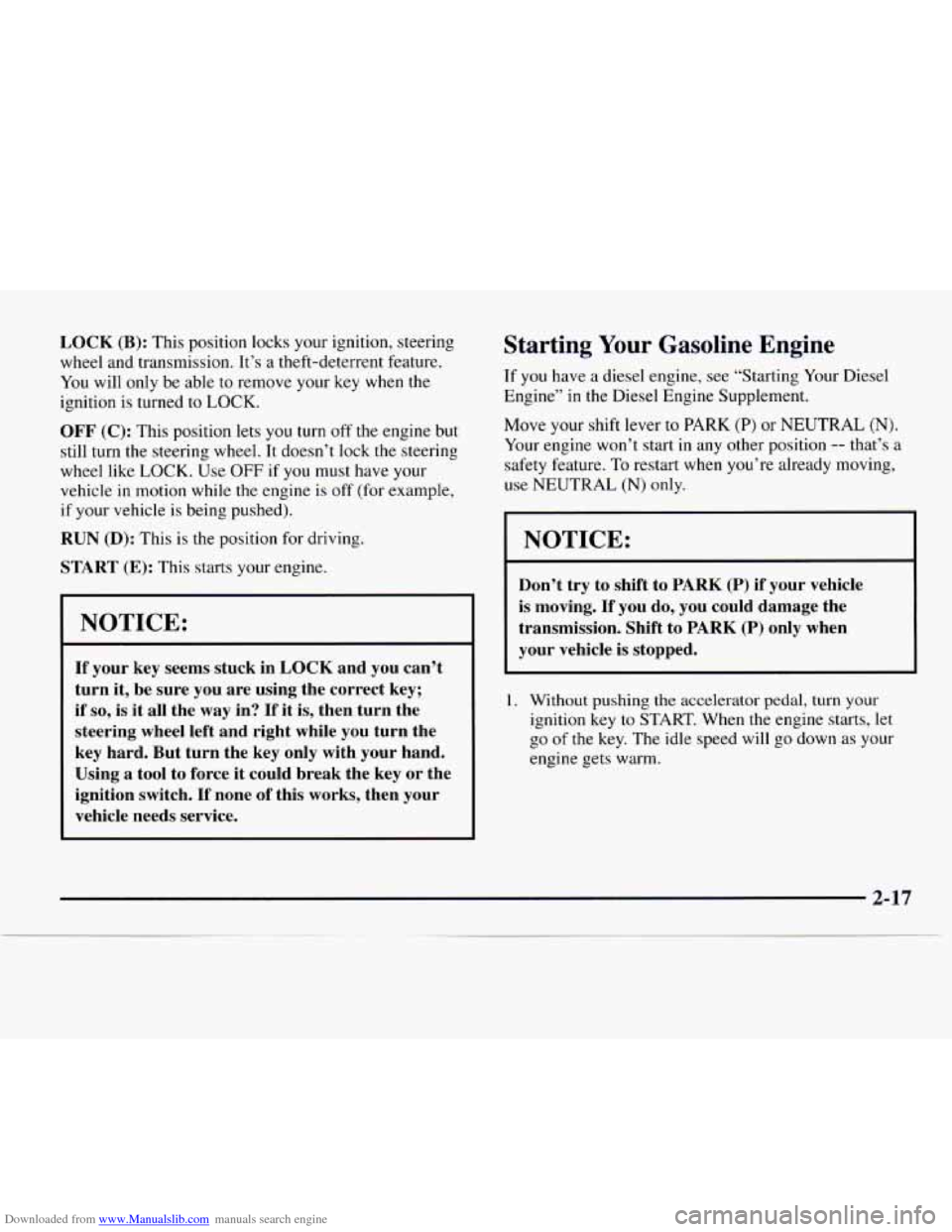
Downloaded from www.Manualslib.com manuals search engine LOCK (B): This position locks your ignition, steering
wheel and transmission. It’s a theft-deterrent feature.
You will
only be able to remove your key when the
ignition is turned to
LOCK.
OFF (C): This position lets you turn off the engine but
still turn the steering wheel. It doesn’t lock the steering
wheel like
LOCK. Use OFF if you must have your
vehicle in motion while the engine is
off (for example,
if your vehicle is being pushed).
RUN (D): This is the position for driving.
START (E): This starts your engine.
NOTICE:
If your key seems stuck in LOCK and you can’t
turn
it, be sure you are using the correct key;
if
so, is it all the way in? If it is, then turn the
steering wheel left and right while you turn the
key hard. But turn the key only with your hand.
Using
a tool to force it could break the key or the
ignition switch.
If none of this works, then your
vehicle needs service.
Starting Your Gasoline Engine
If you have a diesel engine, see “Starting Your Diesel
Engine”
in the Diesel Engine Supplement.
Move your shift lever to PARK
(P) or NEUTRAL (N).
Your engine won’t start in any other position -- that’s a
safety feature. To restart when you’re already moving,
use NEUTRAL
(N) only.
I NOTICE:
r
Don’t try to shift to PARK (P) if your vehicle
is moving.
If you do, you could damage the
transmission. Shift to
PARK (P) only when
your vehicle is stopped.
1. Without pushing the accelerator pedal, turn your
ignition key to START. When the engine starts, let
go
of the key. The idle speed will go down as your
engine gets warm.